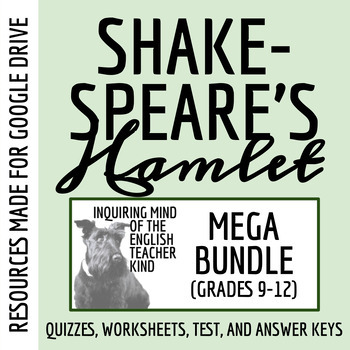Hamlet Quiz, Close Reading Worksheet, Test, and Answer Key Bundle (Google Drive)
- Google Drive™ folder

What educators are saying
Products in this Bundle (26)
showing 1-5 of 26 products
Description
This low-prep bundle covering Hamlet by William Shakespeare contains all the formative and summative assessments teachers need to assess general reading comprehension, support the development of close reading analysis skills, and greatly reduce take-home grading responsibilities. Included are five multiple choice quizzes; nineteen close reading worksheets, each covering a single scene; an end-of-unit test; and answer keys. Materials are made for Google Drive, offering self-grading functionality for multiple choice questions and built-in feedback for short answer questions. (Alternatively, a printable bundle option is available.)
By engaging with these resources, students will have opportunities to perform the following tasks:
- Identify what the text states explicitly and implicitly
- Define words and phrases as they are used in the text
- Discern the tone of given passages
- Determine the functions of given scenes
- Analyze plot from a historical perspective
- Consider the greater significance of given details
- Explore how complex characters think, behave, interact, and develop
- Compare and contrast characters
- Examine the effect of Shakespeare's narrative techniques with emphasis on the incorporation of figurative language
- Apply knowledge of literary devices including metaphor, simile, euphemism, personification, hyperbole, oxymoron, situational irony, dramatic irony, and more
- Conduct brief research to answer a question connecting the drama to aspects of Greek mythology
- Consider autobiographical parallel, drawing an informed inference about Shakespeare's philosophy on the purpose of dramatic performances based on details provided in a given scene
- Explore themes with emphasis on humanity's relationship with the universe
- Support claims and inferences with sound reasoning and relevant textual evidence
- Write about Shakespearean drama with clarity, accuracy, and precision
Materials in this bundle may facilitate small-group discussions in which students decode language and pose/respond to questions relating to plot, broad topics, and character development. Using these resources for structured guidance, students will improve their ability to present information, conclusions, and supporting textual evidence clearly and convincingly.
Materials are available for teaching a variety of Shakespeare’s plays:





